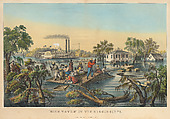"High Water" in the Mississippi
Frances Flora Bond Palmer American, born England
James Merritt Ives American
Lithographed and published by Currier & Ives American
Not on view
Currier & Ives issued more than thirty lithographs of the great Mississippi River; those pictures showing steamboats ranked among the most popular. In the nineteenth century, steamboats provided important and practical large-scale transport of passengers and goods both up and down this mighty river; such riverboats navigated the shallow waters, as well as upriver against strong currents, thereby helping to develop trade between America's heartland and the Gulf Coast.
In the years immediately following the American Civil War, Currier & Ives were eager to take advantage of a new market of prospective customers, including those who wished to remember some aspects of life in the South. As residents who lived along the Mississippi River were well aware, their fields and homes were often threatened by periodic floods when river water levels overflowed its banks. This lithograph presents Black people and white people courageously coping with such a natural disaster, while in the background, the steamboat "Stonewall Jackson" (named for a Confederate general in the American Civil War who had died in 1863) progresses unhindered along the river. In the foreground of this flooded plantation scene, beyond a row of uprooted and partially submerged trees, a Black family finds precarious safety on the rooftop of a humble dwelling. While the Black mother and three children sit atop the roof's highest section, two men holding long poles and a woman try to retrieve furniture (a table and a chair) floating on the floodwater. Another man pulls the bridle of donkey swimming in the water; on the far side of the roof, a girl stands looking at the devastation. In the right background -- beyond a flooded chicken coop (with chickens on its rooftop), floating cargo containers, and two men in a rowboat-- is a grand two-story house (with the water level approaching the second story); standing at the top of the house is a white man (waving to signal for help) and a woman. Recent scholars have provided varying insights into the complexities revealed by such images. Some interpreted this as a poignant image of recently freed enslaved people struggling to survive in a devastated South, yet the white residents retained the "higher ground" literally and figuratively.
Nathaniel Currier, whose successful New York-based lithography business had thrived since 1835, produced thousands of hand-colored prints in various sizes that together create a vivid panorama of mid-to-late nineteenth century American life. After1857, when Currier made James Merritt Ives a partner, the renamed Currier & Ives firm continued until 1907. Frances Flora (Fanny) Palmer was one of the most important artists working for Nathaniel Currier, and later Currier & Ives, between 1849 and 1868, when she produced approximately 200 of the firm's best landscapes and most engaging scenes of daily life.
This image cannot be enlarged, viewed at full screen, or downloaded.


